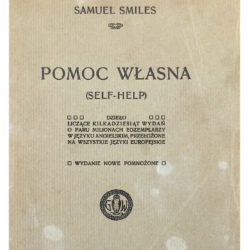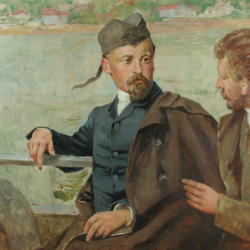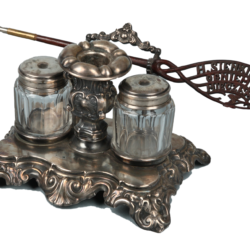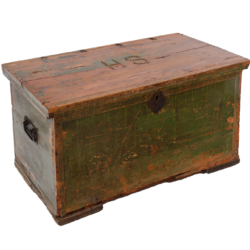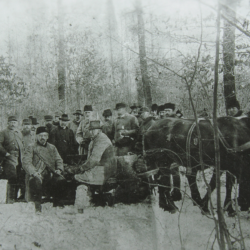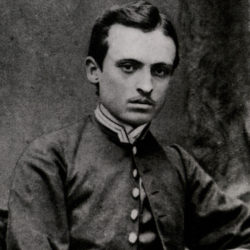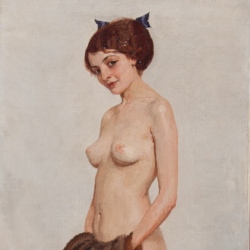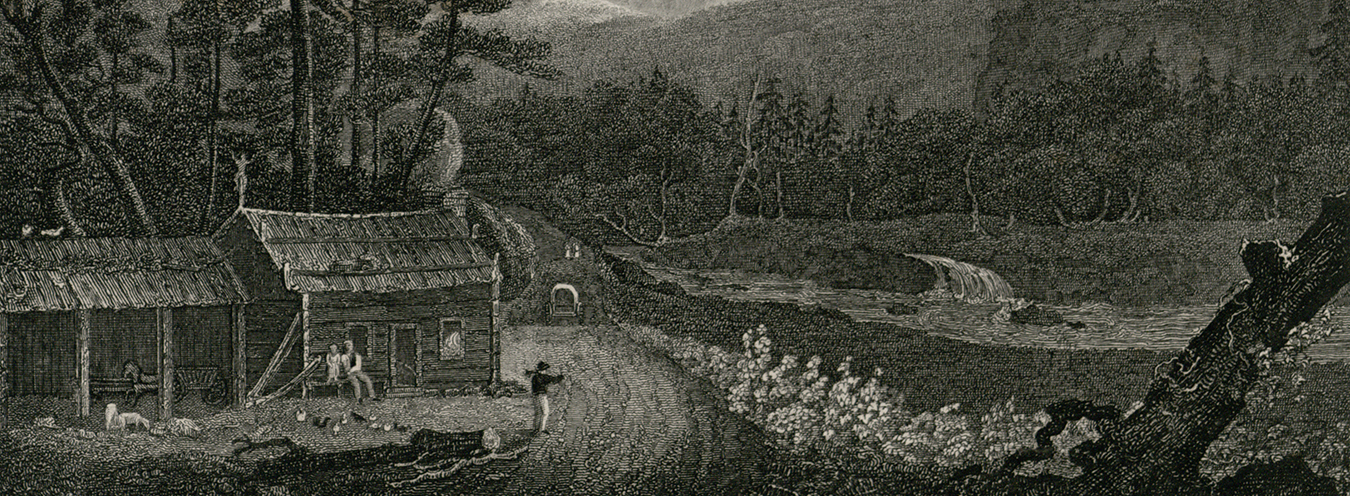
“I learnt this in America”
It is often believed that the American trip shaped Sienkiewicz, being the first turning points in his writing biography (the trip as a threshold is the starting point of Tadeusz Bujnicki’s paper[1]). Zdzisław Najder[2] considers this period as the key period in Sienkiewicz’s life and work. Jerzy R. Krzyżanowski even wrote: “Bearing Sienkiewicz’s future delight in the free life in the grasslands in mind, clearly visible in Trylogia [Trilogy], the Californian period can be considered as a practical exercise in creating the literary images of life on the frontier grasslands.”[3]
On the pages of Listy z podróży… [Letters from the Trip…], the trip to America is presented as an experience that was difficult, yet leading to an impressive victory over one’s own limitations, both physical and imposed by social conventions and habit. In real life, the travel experiment failed, and Sienkiewicz paid for it with a period of depression and disillusionment (the long-lasting and ambiguous relation with Modrzejewska must have included serious emotional engagement of the young author[4]) as well as financial problems (since he had to borrow money for the return trip to Liverpool from captain Piotrowski[5]).
Sienkiewicz, the promising journalist, who in March 1876 set out to conquer California, was almost thirty years old, but he was described (and often described himself) as a youngster. He was perceived as such by Sewer in his London letter to Karol Chłapowski, dated as of February 24, 1876 (where he wrote about “the youngster”); the writer himself (?humorously) presented himself in a letter to Horain in the following way: “they [the Chlapowskis – A.B.] were met by a young and exceptionally handsome gentleman, that is: myself.”[6] He was similarly portrayed in Modrzejewska’s memoirs (this “young novelist” was exceptionally “strong, healthy and ruddy-faced” after sea swims in the nearby Anaheim Landing)[7].
Having returned from America, Sienkiewicz spent the next year in France, crossing not only the symbolic age limit (he turned 33, the age of Jesus Christ when he died on the Cross, and in European culture the thirtieth birthday was a kind of border, separating youth from maturity), but also coming to terms with his experiences and taking significant life decisions which could be summarized in one word: stabilization. This stabilization included not only the choice of professional career (turning from a journalist to a novelist) and liberation from the long-lasting fascination with Modrzejewska, but also meeting in September 1876 in Venice and establishing a closer acquaintance with the Szetkiewicz sisters, followed by a long-lasting period of courting Maria Szetkiewicz, crowned with their wedding on August 18, 1881[8]. During their engagement, Sienkiewicz was already thirty-four years old, and was by reputation “a man of indeterminate profession, reckless and indebted.”[9][9] He was probably painfully aware of this since, for some time, he had been seriously negotiating financial terms with his publisher. The negotiations started half-jokingly already during his trip to America. This is clearly visible in his letters to Edward Le, for instance in the letter sent in February 1877:
I have not been informed what is going on with my writings – if you are going to publish them. I expect so. Despite the fact that I flourish here in hiding like a violet, I have received various offers, which I have not accepted, willing to work only for Gazeta. So, I hope it is quid pro quo.
As far as my remuneration is concerned, I have no doubt it is going to be humongous and unprecedented – obviously in plus. You are telling me that “the paper is growing”, from which I conclude that the pocket is growing as well. Finally, since the business has been joined by a new partner, the proverb that comes to my mind is “strike while the iron is hot.”[10]
And later, in the same letter, he wrote in a seemingly humorous way:
I have been turning into a businessman, to such an extent, that it comes to my mind that the astronomical sums that I pay for my letters should be covered by the paper. But never mind.[11]
By no means was it the subject of minor importance to the correspondent since, just after this nonchalant declaration, he asserted his copyright to the potential second edition of Szkice węglem [Sketches Made with Coal], mentioned in this letter under the title of Barania Głowa [Muttonhead].
A very uncompromising tone can be heard in the letters from Paris, concerning financial issues and written less than a month after the writer’s return from New York. The letter from Paris (written around April 20, 1878) was almost an ultimatum; the young correspondent openly presented his situation in life, listed his needs, emphasized his “market value”, and simply dictated the terms and conditions of further cooperation:
I agree with the paper’s tendencies; secondly, when I think that I am thirty, but I have neither savings nor financial perspectives, it comes to my mind that I should perhaps put myself first. […] You have to consider the fact that in light of the growth of papers and the competition among them, the value of their cooperators – especially those who have gained some recognition – is growing as well. You can conclude that on the basis of the prices and the conditions that I am currently offered.
What is going to happen and who is finally going to write to all those newspapers – I don’t know. I only know that the writers will be auctioned – the one who gives more, wins. As far as you and I am concerned – you don’t have to offer the most since it involves the matter of heart – you need to offer enough, and make things work in such a way that I am able to live.”[12]
“The matter of heart” did not veil the most important issue, that is the negotiation of the most beneficial terms and the highest prices for the texts, and simultaneously maintaining the right to cooperate with other magazines. In support of his arguments, Sienkiewicz did not hesitate to list the titles and names of other bidders, and openly formulated the rule that he was now going to obey, and that would lead to his unprecedented artistic and financial success:[13]
You wouldn’t believe how wanted the exhibition correspondents are. […] Now, Unger may attack me. As you know, Nowiny wants me, too. What Wiek and Gazeta Warszawska are going to do – I don’t know. I have had offers from Galicia, but I am not going to accept them. Anyway, I found myself in a strange position. My sister is getting married on May 1. They are cordially inviting me to come – my heart and the sense of duty tell me that I should go, but again: it’s easy to go, but more difficult to return. And it’s also difficult to miss such a harvest. I spend 3 francs per day in Paris, including accommodation. I cook my morning and evening meals. I learnt this in America – as well as I learnt to self-help. And the exhibition will raise the prices – so, one has to write and one has to earn.[14]
This sober conclusion of a private nature was – one could say – also the side effect of “American therapy”.
Przypisy
- T. Bujnicki, “Sienkiewicz przekracza grancie. O ‘przełomie’ w życiu i twórczości pisarza [Sienkiewicz crosses the borders. About ‘the Turning Point’ in the Life and Works of the Writer], Wiek XIX. Rocznik Towarzystwa Literackiego im. Adama Mickiewicza [19th Century. The Yearbook of Adam Mickiewicz Literary Society] 2009, year. 2 (44),
- Z. Najder, “O ‘Listach z podróży’ do Ameryki Henryka Sienkiewicza” [About Henryk Sienkiewicz’s “Letters from the Trip to America”], Pamiętnik Literacki [Literary Diary] 1955, vol. 2
- J.R. Krzyżanowski, “Na kalifornijskim szlaku Sienkiewicza” [On Sienkiewicz’s Californian Trail], Pamiętnik Literacki [Literary Diary] 2003, issue 2, p. 87.
- In the already cited letter to Daniel Zgliński, Sienkiewicz offers very personal advice regarding the winning of the beloved woman to whom one feels “unfortunate passion” and “terrible addiction” of desire and jealousy: “Oh, I can tell you that it is simply unbearable, and you will be hitting your head against the tree, and when you think that, perhaps, she is kissing somebody else, maybe she is putting out for somebody, then you will be biting your hands and getting furious, […] and you will feel like yelling in your Dunkirk or in the woods, and you – the so far good-natured man – will be pondering the ways to poison, kill, drown and quietly bury in the ground those who separate you from her all the time.” (H. Sienkiewicz, Listy [Letters], vol. 5, part 2, p. 591. The youthful fascination with the great actress was supposed to be so strong so as to lead the author of Szkice węglem [Sketches Made with Coal] across the Atlantic but also many years later, induced him to write a story entitled Ta trzecia [The Third Woman] (written in 1888) which was a hidden homage to Modrzejewska, who was portrayed as the perfect Ewa Adami. (R.Koziołek, op. cit., pp. 24-25)
- J. R. Krzyżanowski, Na kalifornijskim szlaku Sienkiewicza [On Sienkiewicz’s Californian Trail], op. cit., p. 92.
- H. Sienkiewicz, Listy [Letters], vol. 1, part 2, op. cit.., p. 378.
- See “Dekady Henryka Sienkiewicza (1876–1886)” [The Decades of Henryk Sienkiewicz (1876-1886)]: www.nplp.pl/artykul/1876-1886/ [access: 2017–07–05] (quoted after: Henryk Sienkiewicz: kalendarz życia i twórczości [Henryk Sienkiewicz: The Diary of Life and Work] (written by J. Krzyżanowski; edited and annotated by M. Bokszczanin, Warsaw 2012).
- Jolanta Sztachelska, referring to the subject research, believes that Sienkiewicz met the Szetkiewicz family in Szczawnica – a spa, in 1879, during an “American lecture”. Maria made such an enormous impression on him that he “decided to follow them to Italy” (J. Sztachelska, “Żona w biografii twórczej artysty. Na marginesie listów Marii z Szetkiewiczów Sienkiewiczowej” [The Wife in The Artist’s Creative Biography. On the Margin of the Letters of Maria Sienkiewicz née Szetkiewicz], Wiek XIX. Rocznik Towarzystwa Literackiego im. Adama Mickiewicza [19th Century. The Yearbook of Adam Mickiewicz Literary Society] 2016, Year 9 (52), p. 430.
- See “Dekady Henryka Sienkiewicza (1876-1886)” [The Decades of Henryk Sienkiewicz (1876-1886)]: www.nplp.pl/artykul/1876-1886/ [accessed on: July 7, 2017] (quoted after: Henryk Sienkiewicz: kalendarz życia i twórczości [Henryk Sienkiewicz: The Diary of Life and Work] (written by J. Krzyżanowski; edited and annotated by M. Bokszczanin, Warsaw 2012.
- H. Sienkiewicz, Listy [Letters], vol. 3, part 2, p. 461.
- Ibidem, p. 462.
- Ibidem, pp. 472-473.
- Ryszard Koziołek wrote: “Despite the inconveniences connected with being a public property, Sienkiewicz was far more a beneficiary than a victim of modern press. Thanks to his talent and knowledge on how it functioned as the medium for literature, he was able to integrate the economic and ideological dimensions of writing without any major contradictions – the achievement that had not been so effectively accomplished by any other writer of his generation. He even managed to modify the awareness of the receivers, who – in his case – did not emphasize the conflict between ‘artistic mission’ and the excellent business that he made out of it.”(R. Koziołek, op. cit., p. 18).
- H. Sienkiewicz, Listy [Letters], vol. 3, part 2, op. cit., p. 475, emphasis. – A.B.
Bibliografia
Podmiotowa:
- Henryk Sienkiewicz, Listy z podróży do Ameryki, Warszawa 1988
- Henryk Sienkiewicz, Listy, t. I, cz. 2, wstęp i biogramy adresatów J. Krzyżanowski, oprac. i przypisy M. Bokszczanin, Warszawa 1977
- Listy, t. III, cz. 2, oprac., wstęp i przypisy M. Bokszczanin, Warszawa 2007
- Listy, t. V, cz. 2, oprac., wstęp i przypisy M. Bokszczanin, Warszawa 2009
- Samuel Smiles, Pomoc własna, spolszczone z niem. obrobienia Józefa Boyesa, Warszawa 1867 (wyd. 2: Kraków 1868; wyd. 3: Warszawa 1979)
Przedmiotowa:
- Tadeusz Bujnicki, Sienkiewicz przekracza grancie. O „przełomie” w życiu i twórczości pisarza, „Wiek XIX” 2009
- Artur Domosławski, Kapuściński non-fiction, Warszawa 2010
- Ryszard Koziołek, Ciała Sienkiewicza. Studia o płci i przemocy, Katowice 2009
- Jerzy R. Krzyżanowski, Na kalifornijskim szlaku Sienkiewicza, „Pamiętnik Literacki” 2003, z. 2
- Jerzy R. Krzyżanowski, Sienkiewicz w Wyoming, czyli „trick or trip”?, „Pamiętnik Literacki” 1996, z. 4
- Joanna Kubicka, Na przełomie. Pozytywiści warszawscy i pomoc własna, Warszawa 2016
- Zdzisław Najder, O „Listach z podróży” do Ameryki Henryka Sienkiewicza, „Pamiętnik Literacki” 1955, z. 2
- Ewa Paczoska, Dojrzewanie, dojrzałość, niedojrzałość. Od Bolesława Prusa do Olgi Tokarczuk, Warszawa 2004
- Joanna Śliwińska, Literat-podróżnik i dama w podróży. O zagranicznych wojażach Sienkiewicza i Orzeszkowej, w: Podróż i literatura. 1864-1914, red. Ewa Ihnatowicz, Warszawa 2008
- Bartłomiej Szleszyński, Kto napisał „Pomoc własną” Samuela Smilesa?, w: Etyka i literatura: pisarze polscy lat 1863-1918 w poszukiwaniu wzorców życia i sztuki, red. Ewa Ihnatowicz i Ewa Paczoska, Warszawa 2006, s. 453-460
- Jolanta Sztachelska, Żona w biografii twórczej artysty. Na marginesie listów Marii z Szetkiewiczów Sienkiewiczowej, „Wiek XIX” 2016, s. 423-444
- Dariusz Trześniowski, „Listy z Afryki” Henryka Sienkiewicza w świetle dyskursu postkolonialnego, w: Podróż i literatura. 1864-1914, red. Ewa Ihnatowicz, Warszawa 2008
- tom „Tekstów Drugich” 2015, nr 2 (Formy męskości – tu zwłaszcza Gunnar Karlsson, Męskość jako projekt: kilka uwag psychoanalitycznych)
- Dekady Henryka Sienkiewicza (1876-1886), nplp.pl /artykul/1876-1886/ (materiał za: Henryk Sienkiewicz: kalendarz życia i twórczości (autor Julian Krzyżanowski; uzup. i oprac. Maria Bokszczanin, Warszawa 2012)

